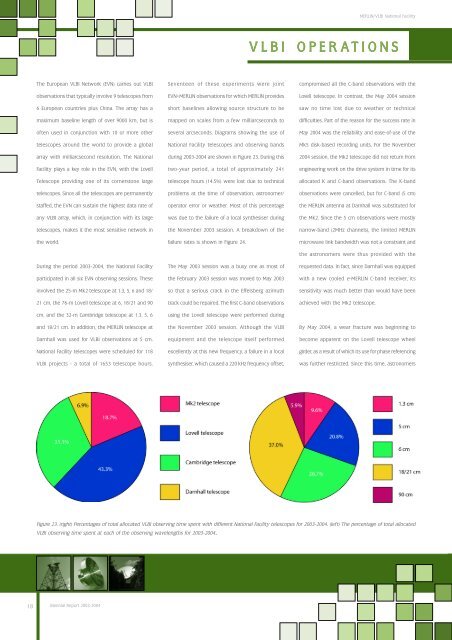Biennial Report 2003-2004 - Merlin
Biennial Report 2003-2004 - Merlin
Biennial Report 2003-2004 - Merlin
Create successful ePaper yourself
Turn your PDF publications into a flip-book with our unique Google optimized e-Paper software.
18<br />
The European VLBI Network (EVN) carries out VLBI<br />
observations that typically involve 9 telescopes from<br />
6 European countries plus China. The array has a<br />
maximum baseline length of over 9000 km, but is<br />
often used in conjunction with 10 or more other<br />
telescopes around the world to provide a global<br />
array with milliarcsecond resolution. The National<br />
Facility plays a key role in the EVN, with the Lovell<br />
Telescope providing one of its cornerstone large<br />
telescopes. Since all the telescopes are permanently<br />
staffed, the EVN can sustain the highest data rate of<br />
any VLBI array, which, in conjunction with its large<br />
telescopes, makes it the most sensitive network in<br />
the world.<br />
During the period <strong>2003</strong>-<strong>2004</strong>, the National Facility<br />
participated in all six EVN observing sessions. These<br />
involved the 25-m Mk2 telescope at 1.3, 5, 6 and 18/<br />
21 cm, the 76-m Lovell telescope at 6, 18/21 and 90<br />
cm, and the 32-m Cambridge telescope at 1.3, 5, 6<br />
and 18/21 cm. In addition, the MERLIN telescope at<br />
Darnhall was used for VLBI observations at 5 cm.<br />
National Facility telescopes were scheduled for 118<br />
VLBI projects - a total of 1653 telescope hours.<br />
<strong>Biennial</strong> <strong>Report</strong> <strong>2003</strong>-<strong>2004</strong><br />
Seventeen of these experiments were joint<br />
EVN+MERLIN observations for which MERLIN provides<br />
short baselines allowing source structure to be<br />
mapped on scales from a few milliarcseconds to<br />
several arcseconds. Diagrams showing the use of<br />
National Facility telescopes and observing bands<br />
during <strong>2003</strong>-<strong>2004</strong> are shown in Figure 23. During this<br />
two-year period, a total of approximately 241<br />
telescope hours (14.5%) were lost due to technical<br />
problems at the time of observation, astronomer/<br />
operator error or weather. Most of this percentage<br />
was due to the failure of a local synthesiser during<br />
the November <strong>2003</strong> session. A breakdown of the<br />
failure rates is shown in Figure 24.<br />
The May <strong>2003</strong> session was a busy one as most of<br />
the February <strong>2003</strong> session was moved to May <strong>2003</strong><br />
so that a serious crack in the Effelsberg azimuth<br />
track could be repaired. The first C-band observations<br />
using the Lovell telescope were performed during<br />
the November <strong>2003</strong> session. Although the VLBI<br />
equipment and the telescope itself performed<br />
excellently at this new frequency, a failure in a local<br />
synthesiser, which caused a 220 kHz frequency offset,<br />
MERLIN/VLBI National Facility<br />
VLBI VLBI OPER OPERA OPER TI TIO TI NS<br />
NS<br />
compromised all the C-band observations with the<br />
Lovell telescope. In contrast, the May <strong>2004</strong> session<br />
saw no time lost due to weather or technical<br />
difficulties. Part of the reason for the success rate in<br />
May <strong>2004</strong> was the reliability and ease-of-use of the<br />
Mk5 disk-based recording units. For the November<br />
<strong>2004</strong> session, the Mk2 telescope did not return from<br />
engineering work on the drive system in time for its<br />
allocated K and C-band observations. The K-band<br />
observations were cancelled, but for C-band (5 cm)<br />
the MERLIN antenna at Darnhall was substituted for<br />
the Mk2. Since the 5 cm observations were mostly<br />
narrow-band (2MHz channels), the limited MERLIN<br />
microwave link bandwidth was not a constraint and<br />
the astronomers were thus provided with the<br />
requested data. In fact, since Darnhall was equipped<br />
with a new cooled e-MERLIN C-band receiver, its<br />
sensitivity was much better than would have been<br />
achieved with the Mk2 telescope.<br />
By May <strong>2004</strong>, a wear fracture was beginning to<br />
become apparent on the Lovell telescope wheel<br />
girder, as a result of which its use for phase referencing<br />
was further restricted. Since this time, astronomers<br />
Figure 23. (right) Percentages of total allocated VLBI observing time spent with different National Facility telescopes for <strong>2003</strong>-<strong>2004</strong>. (left) The percentage of total allocated<br />
VLBI observing time spent at each of the observing wavelengths for <strong>2003</strong>-<strong>2004</strong>.


